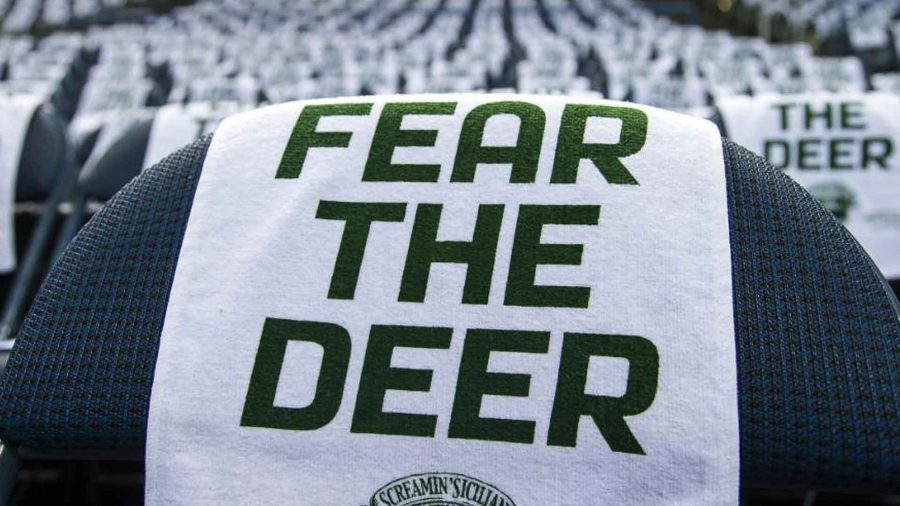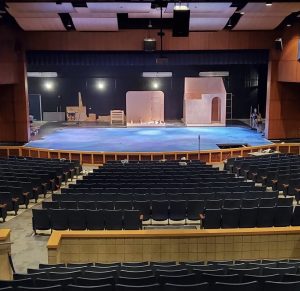Deal or no deal
http://vancouverbasketball.ca/2015/07/17/sorry-seattle-milwaukee-is-keeping-the-bucks-but-would-it-have-been-better-off-without-them/
Towels line the seats in BMO Harris Bradley Center with their motto “Fear the Deer”. The MIlwaukee Bucks have released their plans for a new stadium. The stadium will be funded by taxpayer dollars.
April 26, 2016
New proposals for a stadium make-over for the Milwaukee Bucks came with threats from the team’s ownership.
The team’s owners gave the city the ultimatum this past summer. Either cough up half of the $500 million proposal for a new stadium, or say goodbye to the Bucks.
These kind of last chance deals are nothing new, and occur at a surprising rate around the country. In fact, St. Louis just lost the Rams to Los Angeles.
But is losing a sports team really the worst thing that can happen to a city?
Most professionals say no. In fact, they argue the opposite.
“If you ever had a consensus in economics,” Michael Leeds, a sports economist at Temple University says, “this would be it.”
Most stadiums are publicly funded through property taxes. Citizens of the city end up paying for construction, but rarely receive any economic return. From 2001-2010 alone, taxpayers gave a total of $12 billion dollars of funding to sports stadiums.
Despite the massive funding, however, taxpayers rarely see a fair return.
An independent study published by John Siegfried and Andrew Zimbalist showed that there is,“…no statistically positive correlation between sports facility construction and economic development.”
“If every sports team in Chicago were to suddenly disappear,” Leeds says, “the impact on the Chicago economy would be a fraction of 1 percent.” This includes eight professional teams. “A baseball team has about the same impact on a community as a mid-size department store.”
Considering the overall wealth of big sports teams, it would be logical to expect a larger return than a “department store.” The Dallas Cowboys, for example, are the wealthiest team, with a bottom line of about $4 billion.
According to the Huffington Post, the taxpayers spent, “$7 billion on stadiums for a league that surpassed $10 billion in revenue” in the 2014-15 season.
Milwaukee isn’t new to using taxpayer money to fund arenas, either. The 2001 building of Miller Stadium had a hefty price tag of about $290 million for taxpayers, paying over half of the total $400 million required.
Affording the new Bucks stadium will cost taxpayers about $250 million dollars up front, but interest is expected to make those prices rise up to about $400 million.
Stadium cost are also being driven up by the demand to make them as lavish as possible. The Marlins, for example, have put a multi-million fish tank in, stretching behind home plate.
It seems that promises of wealth and economic stimulation often come with unforeseen side effects. In Indianapolis, a new Colts’ stadium forced the city to raise hotel, rental car, and restaurant taxes, among others. Usually, teams get away with this by attacking a city’s vulnerability.
The Wall Street Journal stated that the deal struck for the Cincinnati Bengals’ and Reds’ new stadiums in Hamilton County was, “…one of the worst professional sports deals ever struck by a local government.” The Bengals, who at the time were also threatening to leave Cincinnati, convinced the city to make a deal that they could not sustain.
In Hamilton County, 1 in 7 individuals are under the poverty line. Still, officials struck the largest settlement ever made by taxpayer dollars in NFL history, using a tax break as their trade off to convince voters to buy in. In 2011, Hamilton County found themselves unable to pay these tax-breaks due to the bills they owed the Bengals. Officials were even forced to sell a public hospital just to stay on top of their stadium bills.
In addition to paying $555 million dollars in construction and infrastructure, officials also promised to continue to dish out money for operating and capital costs. To top it off, the final part of the deal included a promise to fund all technological advancements- even those that haven’t been invented yet, including a “holographic replay machine,” funded by the taxpayers.
Counties, it seems, will do whatever it takes to keep teams in their city, even if it means cutting into education. This past September, BuzzFeed News found New York State had diverted $200 million from education funds to support horse racing. In 2011, Texas cut thousands of teachers the same year they signed a deal to give Formula One racing $25 million a year for a full decade.
The argument here is not that professional sports should not be receiving new stadiums, nor that taxpayers should not play a role in getting them a stadium. The larger problem, rather, is that there is no give and take. Either the taxpayers help pay for it, and share the income with the team, or taxpayer dollars get redirected. If the taxpayers are going to pay for these stadiums, there has to be an expected, consistent return, or no deal.






